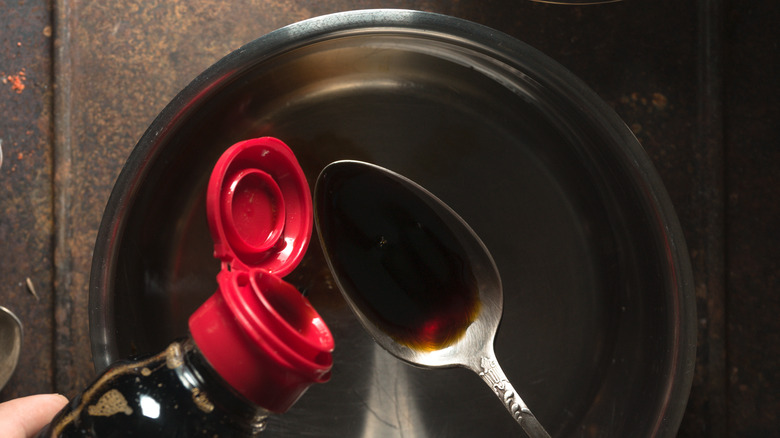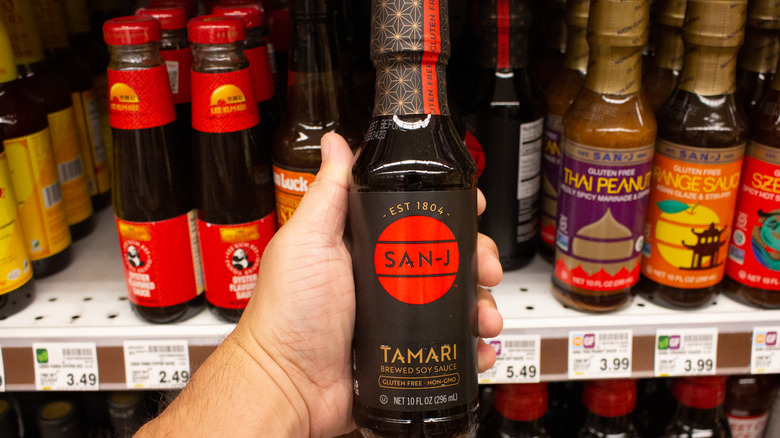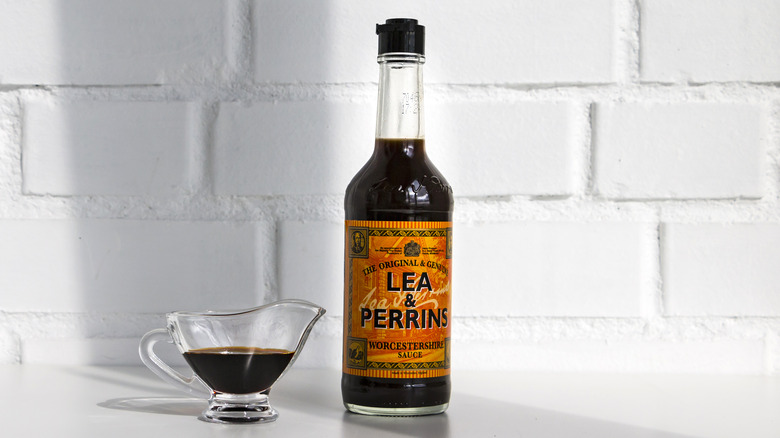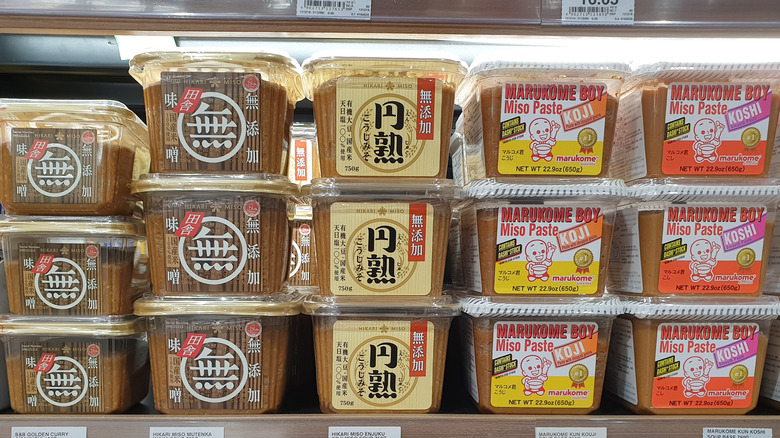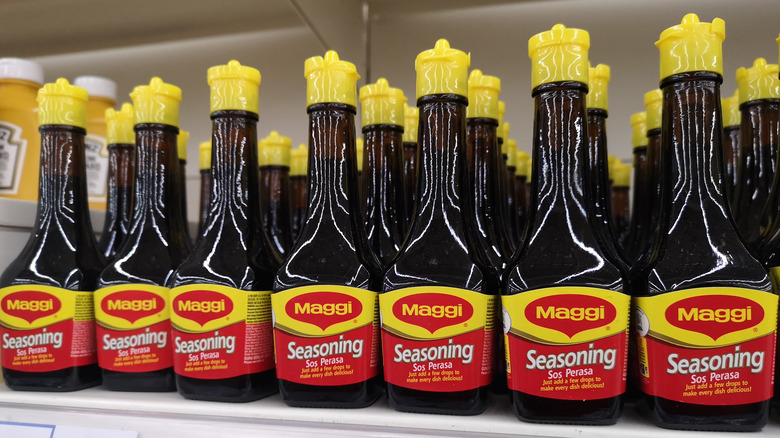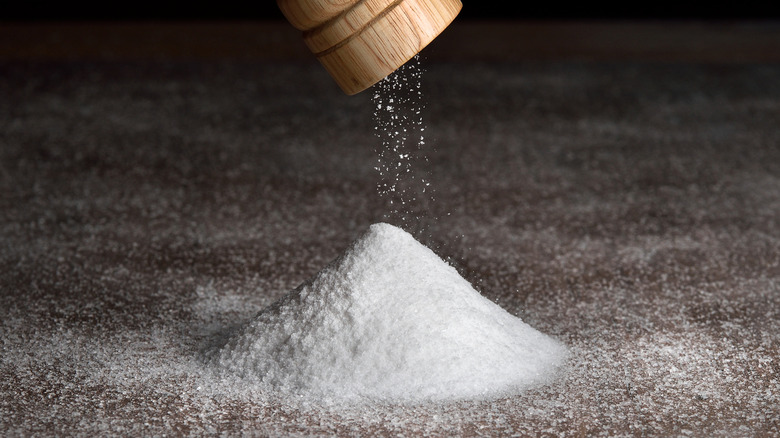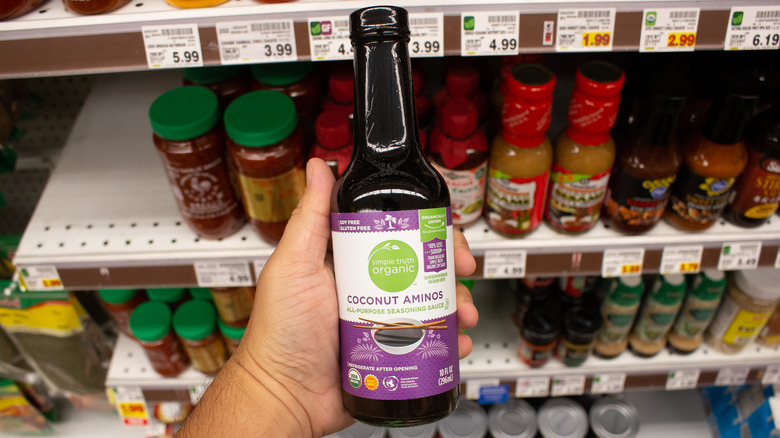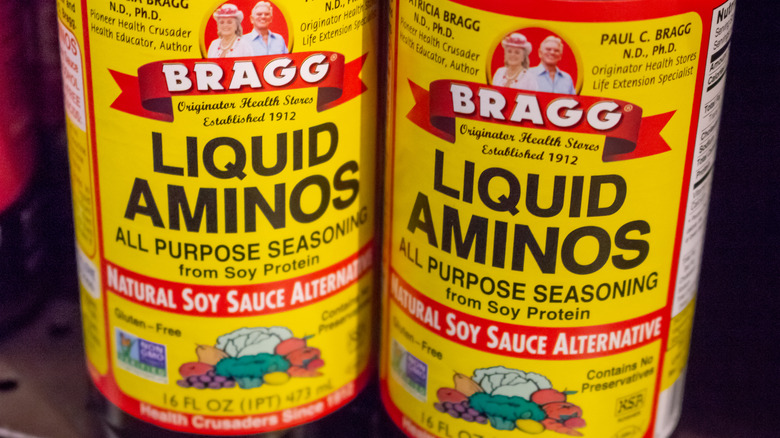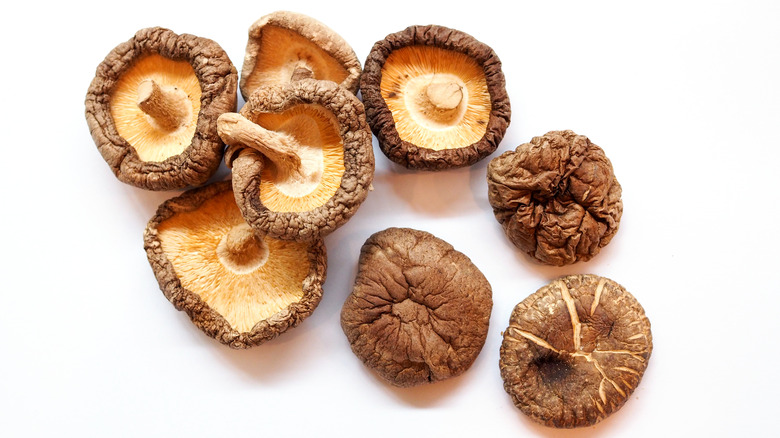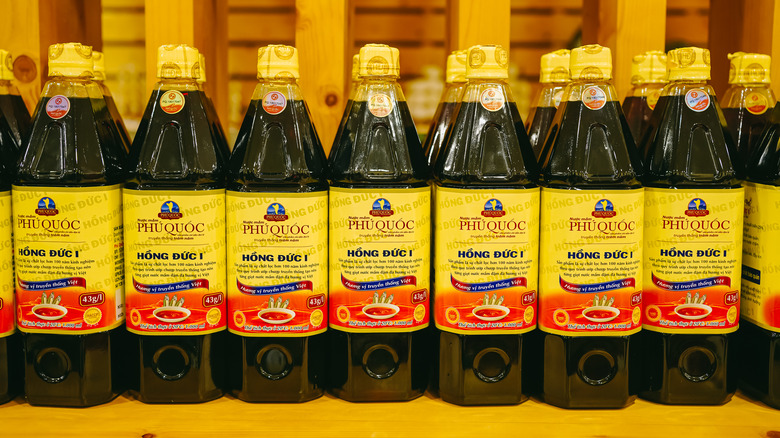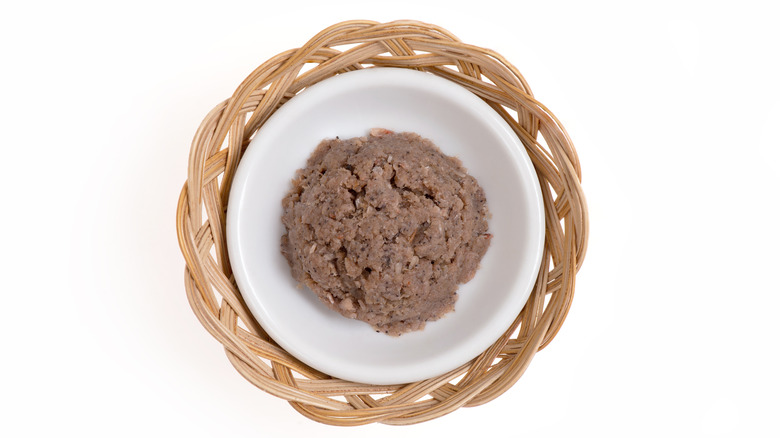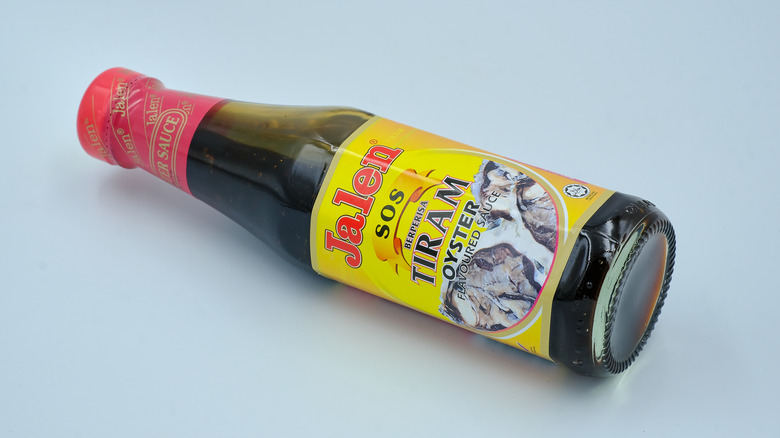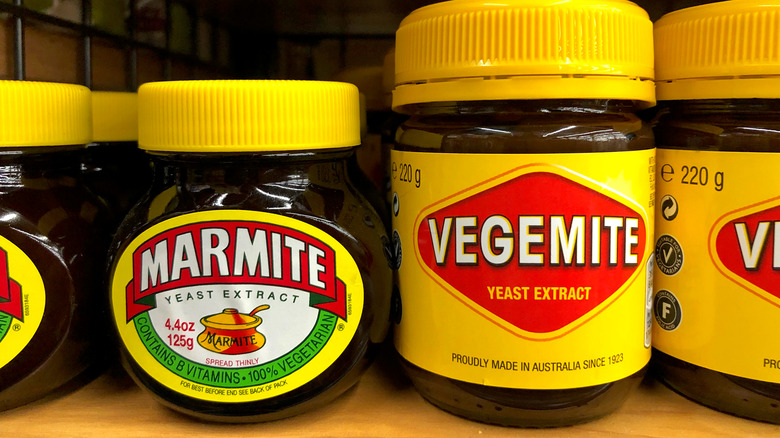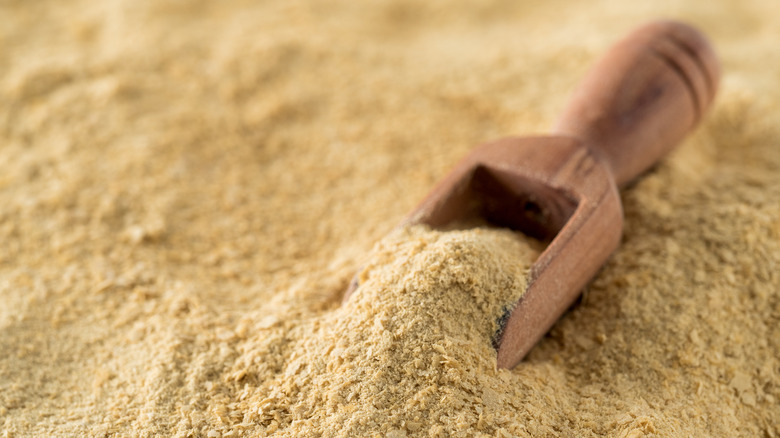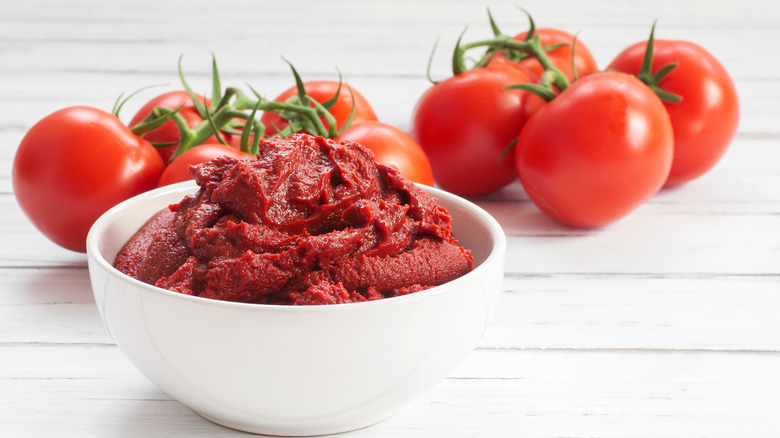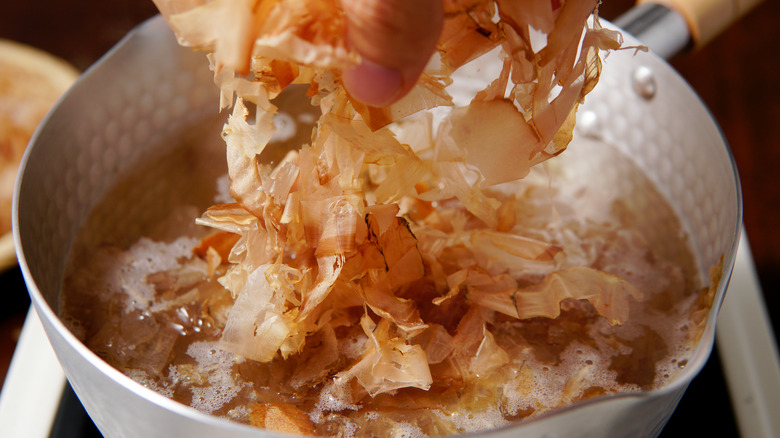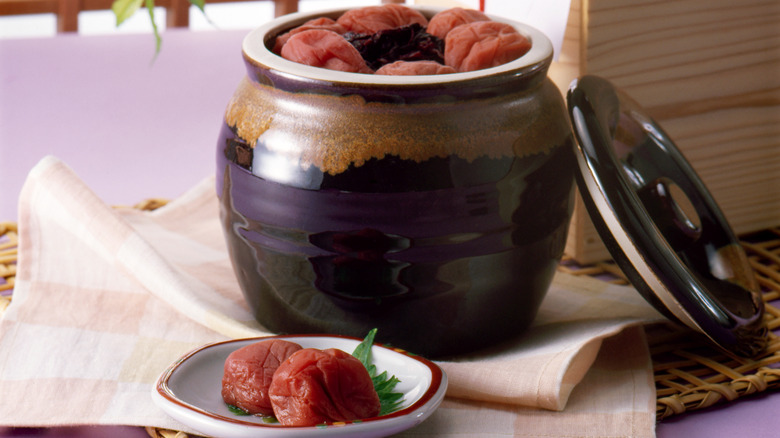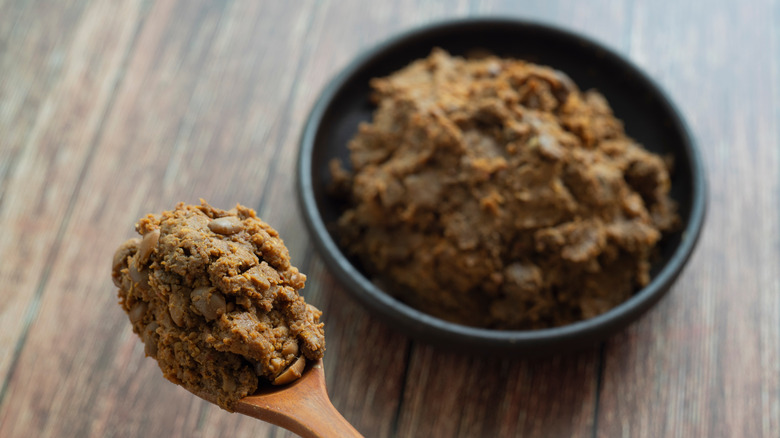19 Best Soy Sauce Substitutes To Use Instead
Picture this: it's a freezing weeknight. The rain is lashing down outside, so you decide to make a delicious East Asian soup (Avocado-Miso Ramen, perhaps?) for dinner. The kitchen fills with steam. You reach for your trusty bottle of soy sauce ... and it's too light. There's only a smidge of salty deliciousness at the bottom. The soup bubbles gently. Did we mention it's raining? There's no way you're going out to get more soy sauce. But is there a substitute lurking in your kitchen that can provide the same depth of flavor?
In order to answer that question, let's examine what soy sauce actually does for a dish. According to Healthline, the word "soy" comes from the Japanese word for soy sauce, "shoyu." The four basic ingredients of soy sauce are soybeans, wheat, salt, and a fermenting agent like mold or yeast. So, when you add soy sauce to a dish you're getting two things: salty goodness and umami flavor.
Umami is one of the five basic tastes (alongside sweet, salty, bitter, and sour), and can best be described as "savoriness." Many foods that are fermented, like the soybeans in soy sauce, have umami flavor, and it's the savoriness you find in monosodium glutamate, or MSG.
When it comes to the best substitute for soy sauce, you want something that imparts either saltiness, umami flavor, or (preferably) both! Here are some recommendations that fit the bill if you happen to be out or soy sauce or are looking for a replacement due to dietary restrictions.
Tamari
If you have celiac disease or gluten sensitivities (and a habit of getting sushi on your lunch break), tamari is the soy sauce substitute you have in your bag at all times. It is made in pretty much the same way as soy sauce, by fermenting soybeans. Specifically, tamari is a byproduct of producing miso, which is made with soybeans, salt, water, and a special fungus called kōji. However, tamari often contains no wheat, making it safe for those who have to follow a gluten-free diet.
Tamari has a stronger umami flavor than regular soy sauce, and it's a little less salty tasting too. It is also darker and has a richer taste. As well as being gluten free in most cases (check the label to make sure), tamari is also vegan, which makes it a popular choice for many in the health food space. To sub tamari for soy, simply keep the ratio 1:1.
Worcestershire sauce
Now, you may not expect anything from the British realm of cuisine to be an effective substitute for soy sauce. But as it turns out, salt and umami are universally beloved flavor profiles, even in a country that really enjoys boiling food. In hindsight, the fact that Worcestershire sauce is an essential ingredient in Bloody Marys was always an indication that it had powers we didn't know about.
Firstly, it's pronounced "wuh-stuh-shuh sauce." Secondly, it dates back to the 1830s and is another fermented sauce (we're sensing a theme) with a base of vinegar — usually white vinegar in the U.S. and malt in the U.K. (It's worth noting that malt vinegar is not gluten free, so check the label if that's an issue for you.)
Worcestershire sauce is usually not vegetarian or vegan, as anchovies, molasses, tamarind, onion, garlic, and other seasonings are added to the vinegar base. But it is salty and savory and delicious, which makes it one of the best soy sauce substitutes. This one is a straight 1:1 swap.
Miso
As the Umami Information Center explains, miso is thought to have been brought into Japan from China, and became a staple of the Japanese diet (in the form of the delightful soup we know and love today) in the Kamakura period (1185-1333). Miso is made of soybeans fermented with salt and kōji, a special fungus that gives miso its delicious umami flavor.
Kōji is grown on soybeans, rice, or barley, and the final miso product is labeled as soy, rice, or barley miso depending on the origin of the kōji. All miso is made from soybeans, but different types of miso have different tastes based on the origin of the kōji. Rice miso tends to be salty and sour, barley miso sweet and light, and soybean miso has that deep, rich taste we know so well.
As it is made of very similar ingredients and in a very similar way to soy sauce, miso is a great substitute for soy sauce that you can swap in 1:1 after you dilute the paste in water.
Maggi seasoning
What we're learning from this investigation into the best soy sauce substitutes is that many countries and regions have their own version of the salty umami condiment that is so characteristic of Japanese and Asian cooking. According to The Spruce Eats, Maggi seasoning, which is made from wheat protein (so it's not gluten-free), was invented by Julius Maggi in Switzerland in the late 1800s. Maggi is popular all over the world, including Africa, Asia, and Australasia, though it remains under-the-radar in the United States.
In addition to the liquid version, it is also available in powder form and as a seasoning cube. The original Maggi recipe is a company secret, but it's definitely vegetable-based, and due to its taste and flavor is believed to contain lovage, an herb that tastes like a combination of parsley, celery, and fennel (via Midland Daily News). You might be able to find the Mexican version, called Jugo Maggi, in your local supermarket. It comes in mild, spicy, and lime flavors.
You can add liquid Maggi to any recipe where soy sauce is required in a 1:1 ratio to get that gorgeous umami bomb flavor.
Salt
Of course, we've all started cooking a meal only to discover that we're running out of staples. Salt is one of the things you're most likely to have on hand to replace soy sauce, and that reason alone makes it one of the best soy sauce substitutes around.
According to Kikkoman USA, their traditional soy sauce has 320 milligrams of sodium per teaspoon, whereas salt has 2,325 milligrams of sodium per teaspoon. Meanwhile, the American Heart Association recommends that adults eat a maximum of 2,300 milligrams per day, and aim for a limit of 1,500 milligrams. So while you can replace soy sauce with salt in your recipe, you'll probably want to avoid a 1:1 ratio!
Try putting in a quarter teaspoon of salt for every teaspoon of soy sauce, or simply put in half a teaspoon of salt per serving of your dish. This substitution is best for dishes that don't rely on soy sauce for much of their flavor, as you will lose the umami deliciousness that soy sauce imparts.
Coconut aminos
This soy sauce sub is probably already in your cupboard if you're vegan, or have gluten and/or wheat or soybean allergies. As the name suggests, coconut aminos are made from a combination of fermented coconut sap and sea salt. Although it is a little sweeter and has a milder taste than traditional soy sauce, it does not taste like coconut, and is lower in sodium, making it one of the best soy sauce substitutes to use if you're on a low-sodium diet. As we mentioned earlier, one teaspoon of the popular Kikkoman soy sauce has about 320 milligrams of sodium, while coconut aminos contain about 90 milligrams per teaspoon.
Despite the many health benefits and nutrients present in coconut, such as potassium, zinc, and magnesium, Healthline reports that there is no evidence that any of these show up in the delicious fermented coconut sap. Try it with a 1:1 swap, but bear in mind that you might need to add extra salt to get the same effect as traditional soy sauce.
Liquid aminos
According to Ajinomoto, umami flavor is basically the taste of an amino acid, glutamate. That taste tells our brains that protein is at hand, which is why it resonates so distinctly — we need protein to live!
Let's drop some science: Our bodies need 20 different amino acids in order to function as well as for proper growth, and nine of those need to be regularly consumed. (The other 11 we make ourselves.) Amino acids are what protein is made up of, and as My Recipes explains, liquid aminos specifically are the concentrated amino acids from soybeans. Liquid aminos are not fermented like traditional soy sauce, but the amino acids give it that umami flavor we love. It has less salt than soy sauce, and tastes a little milder and sweeter too.
Like tamari and coconut aminos, liquid aminos are gluten-free and vegan, being made of only soybeans and water. As the tastes are so similar, you can use your liquid aminos for a 1:1 soy sauce substitute.
Dried shiitake mushrooms
If you're looking for a dose of umami goodness, the Umami Information Center recommends dried shiitake mushrooms. Although fresh shiitake mushrooms are also high in umami, drying them enhances that distinctive flavor.
Simply chuck them into your dish as is and leave your food to simmer for as long as you can, or do as Japan Eight recommends and rehydrate the mushrooms in water. You can leave them overnight in cold water (enough to cover your mushrooms), or follow the lead advice of Bon Appétit and pour boiling water on them for a faster rehydrating experience. Then use the liquid in place of your soy sauce.
Note that the flavor is a little more subtle than traditional soy sauce, so you might want to combine it with some extra salt. If you don't have shiitake mushrooms on hand, any other dried mushroom will do as all these fantastic fungi will give you that amazing umami taste. The Umami Information Center especially recommends shimeji, enoki, and button mushrooms.
Anchovies
If you've ever had anchovies on a pizza, you're well aware that they're packed with salty, fishy flavor. Some people love them, and others absolutely loathe them, but not everyone knows that a couple of anchovies will disappear into a sauce and add nothing but delicious depth of flavor.
As Love Food explains, anchovies add a gorgeous umami taste to many recipes. As the fish are usually cured in salt, they add saltiness to any dish, and that salt and umami combination makes them a great soy sauce substitute. Anchovies in a jar (usually packed in oil) can be stored in the fridge for about six months, and as you only use a few at a time you might just have some on hand for that soy sauce emergency.
They're not the best for a stir fry or a similar preparation, but two or three anchovy fillets will melt right into a sauce or soup. Note: anchovy paste also works well, if you don't have anchovy fillets.
Fish sauce
Vegetarians and vegans, just keep on scrolling. To everyone else, stick around, because fish sauce is one of the best soy sauce substitutes to keep in your fridge. Fish sauce is very popular in Southeast Asian cuisine, such as those of Thailand and Vietnam, but it is also found in Korean cooking. The salty flavor and umami depth of fish sauce make it a fantastic replacement for soy sauce if you've run out.
While soy sauce is made of soybeans fermented with salt, fish sauce is made of fish (often anchovies, but usually whatever fish is prevalent in the area) fermented with salt. You can swap fish sauce in for soy sauce at a 1:1 ratio but Spiceography recommends taking out a portion of the fish sauce and subbing in lime or lemon juice to offset some of that fishy flavor. Keep in mind that unlike soy sauce, fish sauce does not add color to your dish, so it can be easy to over pour and over flavor!
Shrimp paste
Shrimp paste is pretty similar to fish sauce, but instead of fish it is made of shrimp fermented in salt (per The Spruce Eats). It originated in Thailand centuries ago, but it is now popular throughout Southeast Asia, including in Malaysia and the Philippines.
Because of its strong, salty taste, you'll want to substitute about half as much shrimp paste for soy sauce in your recipe. Shrimp paste can vary in color and taste depending on where it's from and what it's made of, ranging from a pale pink to a deep brown color. Some varieties are purely salty, while others are salty and sweet. There are different textures too, from drier pastes to more watery, liquid ones. If you're not sure what kind of shrimp sauce you have, add just a little at a time to your dish and taste. Make sure that you mix it in well so that it has completely dissolved into your dish.
Oyster sauce
Whether you think oysters eaten straight from their shell with a squeeze of lemon (or perhaps a dollop of cocktail sauce) are delicious, or you hate the taste and texture and would rather stick to the champagne, oyster sauce is a condiment you need to try. Exceptions on this matter exist only for vegetarians and vegans, because oyster sauce is delicious.
The sauce is made with sugar, salt, corn starch, flour, coloring, oyster extractives, and monosodium glutamate, or MSG. Like soy sauce, the deep brown color of oyster sauce will change the color of your dish.
But how does oyster sauce taste? Well, it has that great umami depth of flavor, as well as the salty goodness and a certain sweetness. You wouldn't necessarily think it tastes of seafood the flavor is definitely savory. However, as Healthline notes, soy sauce is saltier than oyster sauce. Therefore, to substitute oyster sauce for soy sauce, you'll want to use a little more than a 1:1 ratio.
Marmite or Vegemite
Vegans, your moment has come! You might have seen Vegemite (or its British equivalent Marmite) in supermarkets overseas, or heard of it from your foodie friends. You might even spread it on your own toast every morning, or have tried it once and sworn never again to let it in your house.
However, if you're out of soy sauce, the dark, salty, savory flavor of Marmite or Vegemite is an excellent substitute. Both Marmite and Vegemite are made with yeast extract, which gives them that depth of umami savoriness. As an extra bonus, they're high in iron and B vitamins, too.
Vegemite, basically the Australian version of Marmite, was invented when World War I led to delays in the shipment of Marmite from Britain to Australia. They taste much the same, but Vegemite is made with celery and onion, as well as additional spices.
If you're adding either to a soup or stew in place of soy sauce, a dollop of Marmite or Vegemite will dissolve nicely, but if adding to a stir fry or similar you'll want to dilute the thick paste with some water first.
Nutritional yeast
And the vegan soy sauce substitutions keep on coming! Now it's time to talk about nutritional yeast. As we mentioned above, this is what gives Marmite and Vegemite their umami flavors, and nutritional yeast has been providing vegan food that rich savoriness (without the meat) for decades now.
It can be used in vegan mac and cheese, as vegetable seasoning, on popcorn, and in any dish where you might want a nutty, cheesy, umami flavor. Nutritional yeast is made by feeding living yeast a nice sugar-rich carbohydrate, like beet molasses, until it has matured. Then, the yeast is heated, pasteurized, and dried, which toasts it a bit and gives it that nutty goodness.
Although it is not as salty as soy sauce, a teaspoon or two in recipes where soy sauce is called for will offer a similar flavor profile. Just don't forget to add some extra salt.
Tomato paste
Okay, so this one seems a bit out of left field, but hear us out: We're after that umami goodness, and concentrated tomato paste has umami in spades. The preparation is pretty basic: It's just a concentrate of tomato juice, simmered for hours and then dehydrated to form the super-flavorful paste we love to buy in tiny cans that then live in the back of the fridge for months. Adding tomato paste to any savory dish can help to bring out the flavor: stock, curry, beef stews or stir fries, you name it. Plus, you might accidentally invent some delicious fusion cuisine.
The Stone Soup recommends a ratio of one teaspoon of soy sauce to one tablespoon of tomato paste. On top of that, add some extra salt to get the right flavor profile, as tomato paste isn't known for being particularly salty. If you're always left with a huge amount in the can after you've made your Bolognese sauce, now you have a reason to use up that extra paste.
Dashi
If your kitchen repertoire is based in Western foods, you might not have heard of dashi. But if you've eaten Japanese cuisine, you've most likely eaten it. Dashi is a seaweed-based stock that forms the base of tons of Japanese dishes and is essential in Japanese cooking.
Traditionally, dashi is made from sheets of dried seaweed called kombu, and katsuobushi, shavings of dried, smoked, or fermented fish. Sometimes, dashi is also made with dried shiitake mushrooms, our old umami bomb friends. Basically, dashi adds flavor depth to any dish that calls for a savory liquid, and of course those ocean salts from the seaweed don't hurt either.
If you're making a soup or stew that requires the soy sauce you finished last week and forgot to replace, a cup of dashi (or dashi in place of other stock) would be a great substitute. If you don't want to make your own, the easiest solution is to throw in some dashi in powder form (like a bouillon cube) like millions of Japanese cooks do every day.
Umeboshi vinegar
On first examination, umeboshi vinegar might not be the most obvious soy sauce replacement, but hear us out: it's delicious. As The Japan Store explains, ume is Japanese for plums, and umeboshi translates as "dried plum." Umeboshi vinegar is made by fermenting dried ume plums in salt with shiso leaves (a mint-like herb), and weighing them down until vinegar emerges. The vinegar is salty, sour, and fruity, but it's the saltiness in particular that makes it a good soy sauce substitute.
The fermentation from the process of pickling the plums in salt also means that umeboshi vinegar has that umami flavor we need in all our dishes. When you're looking for the best soy sauce substitute, the formula is pretty simple: umami plus salt equals dinner perfection. If you can't get both umami and salt in one ingredient, one or the other will do, but in the case of umeboshi vinegar, it definitely checks both boxes. Go ahead and substitute 1:1.
Parmesan cheese rinds
Next time you grate up a whole block, don't throw your Parmesan rinds away! Save them in a freezer bag and use them to make stock, or simply add one in with your soup or stew. Vegetarians who love to cook have known about this hack for years, but many meat-eaters have yet to realize that substituting Parm rinds for chicken or beef bones in your homemade stock makes an absolutely delicious vegetarian version. Just because it's the end of the cheese doesn't mean it's bad for you. Taste of Home notes that the rind is full of fat, salt, and amazing umami flavor. Salt? Umami? Sound like something familiar?
Simmering the rinds in liquid will soften them, and they might even dissolve into the dish. If there's any left, you can fish it out and throw it away, or even slice it up and add it back in — it still tastes like Parmesan cheese, after all!
Doenjang
Miso fans, here's an ingredient you need to know about: its Korean cousin, doenjang. The condiment (which is pronounced "DEN-jang") is made of soybeans, fermented with salt into a paste. It's thick, it's brown, and it has that amazing salty-sour-umami flavor that makes us want to eat the whole pot of soup. So far, so miso, right?
Well, Kimchi Mari shares doenjang differs from miso in that it is not fermented with rice or other grains. It has a smell not unlike blue cheese (but it doesn't taste like Gorgonzola, don't worry!) Doenjang also has a different texture to miso; where miso is smooth, doenjang is a lot coarser. It ferments for at least six weeks, but can be fermented for years, with some families even passing down jars over generations.
Doenjang is very salty, so it's best to add it to your dish to taste, a little at a time. Still, that fermented umami flavor and rich saltiness make doenjang one of the best soy sauce substitutes.
